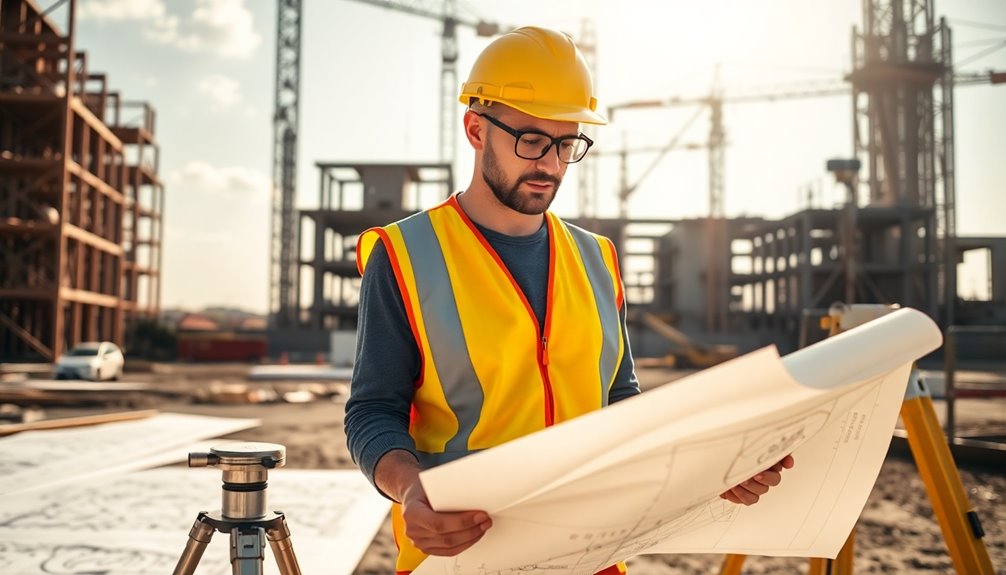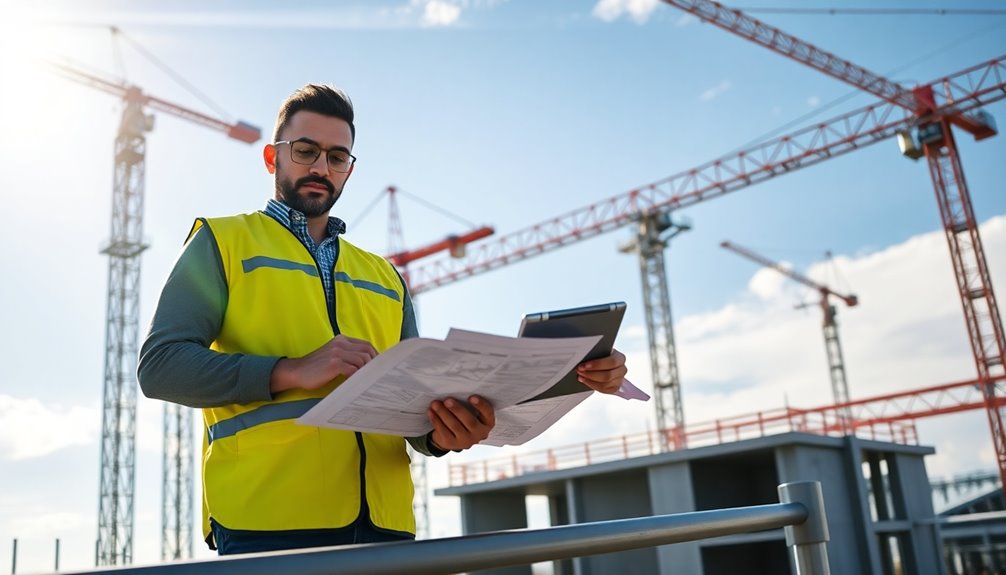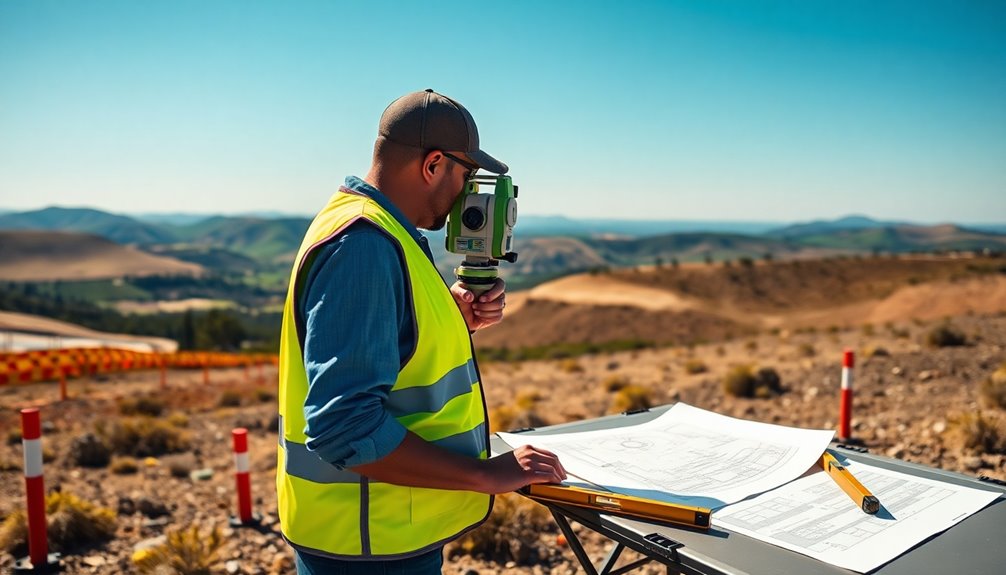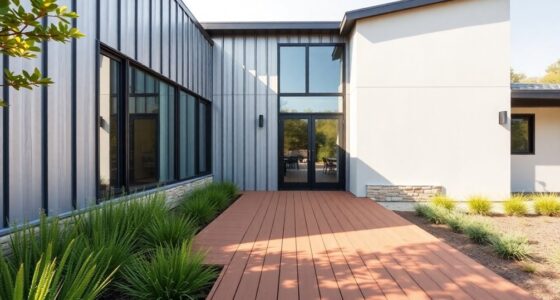A geometra is an essential professional in Italy who manages property-related projects and guarantees they comply with legal standards. You'll find them conducting land surveys, reviewing properties, and overseeing administrative filings with local authorities. They work closely with architects and engineers to create project plans and monitor construction progress. Their expertise helps resolve disputes and maintain compliance with building codes. To become a geometra, individuals typically undergo extensive education and internships, followed by a state exam. There's much more to uncover about their specialized roles and responsibilities that can benefit your understanding of property management.
Key Takeaways
- A geometra is a skilled professional in Italy specializing in property projects, ensuring compliance with building codes and regulations.
- They conduct technical property reviews, manage administrative filings, and obtain approvals from local authorities.
- Geometras perform land surveys, assist in boundary disputes, and conduct due diligence for structural deficiencies.
- They collaborate with architects and engineers to create project plans and oversee construction progress through inspections and meetings.
- Their role includes handling legal and administrative tasks, addressing objections, and maintaining compliance with federal, state, and local regulations.
Definition of a Geometra

A geometra is a skilled professional in Italy who specializes in surveying and managing property-related projects. Your role involves guaranteeing properties comply with building codes and verifying that layouts match municipal blueprints.
You'll check for structural deficiencies and code violations during due diligence, handling all necessary administrative filings and approvals from local authorities. A geometra is also qualified to perform technical property reviews to ensure compliance with local regulations.
In project management, you arrange projects of all sizes, draft detailed plans, and provide cost and time estimates. You coordinate with various professionals, overseeing construction and renovations to make sure everything runs smoothly.
Additionally, you conduct land surveys, resolve boundary disputes, and assist clients in obtaining permits while maneuvering local regulations. Your expertise is essential for guaranteeing compliance with urban, construction, and environmental rules.
Education and Qualifications

To become a geometra, you'll need a solid educational foundation and specific qualifications. This typically involves five years of study at a technical college, focusing on surveying, building, and architecture. You'll cover core subjects like drawing floor plans, researching properties, and understanding building codes.
Additional training might include courses on utilities and building systems.
After your studies, you'll complete a two-year internship before taking the state exam to qualify. Once you pass, you'll enroll in the college of Geometras in your province. Postsecondary training is often part of the pathway to becoming a geometra, ensuring you have the necessary skills and knowledge for the profession.
Continuous education is essential to stay updated on regulations. Some specializations, like energy efficiency audits, require specific certifications, ensuring you're well-equipped for the demands of the profession.
Roles and Responsibilities

While maneuvering the complexities of property management and construction, geometra professionals take on a diverse array of roles and responsibilities.
You'll handle administrative filings with local authorities, guaranteeing compliance with land use regulations and addressing any objections.
Conducting due diligence is vital, as you identify structural deficiencies and verify property layouts against official blueprints. Your expertise in local building codes ensures that all modifications meet the required standards.
You'll coordinate construction project aspects, managing proposals and collaborating with GIS and Survey departments.
Additionally, you provide support in dispute resolution for clients, liaising with regulatory agencies and mentoring junior staff.
Your technical expertise guarantees all projects adhere to federal, state, and local regulations, allowing you to maintain a smooth workflow throughout the property management and construction processes.
Project Oversight

Project oversight is essential in guaranteeing the success of any construction endeavor, as it involves meticulously coordinating various elements from planning to execution.
You'll collaborate with architects and engineers to create thorough project plans, gathering data to address environmental concerns and define engineering needs. This foresight helps identify risks early, avoiding costly mistakes.
Daily inspections and regular meetings keep the project on track, utilizing technology for real-time monitoring. You'll manage risks by guaranteeing quality assurance and adapting to challenges as they arise. Effective project oversight is crucial for error minimization, ensuring execution according to plans and reducing the likelihood of rework.
Clear communication with stakeholders fosters transparency, keeping everyone informed and engaged. By coordinating change requests and resolving issues swiftly, you help maintain momentum and guarantee the project aligns with specifications and standards.
Legal and Administrative Tasks

Maneuvering the legal and administrative tasks in construction is vital, as it guarantees compliance with local regulations and building codes. As a geometra, you'll need to understand building codes and verify that property layouts conform to official blueprints.
You'll handle administrative filings for any modifications, expansions, or renovations, making sure all necessary approvals are obtained from municipal authorities. Additionally, you'll file paperwork for land or building use and address objections from local authorities. It's essential to conduct due diligence to identify any structural deficiencies or code violations, certifying compliance with anti-seismic laws. Moreover, having strong organizational skills is crucial to efficiently manage all documentation and ensure timely submissions.
Limitations and Collaborations

Understanding the limitations of a geometra's role is vital, as it shapes the way you'll collaborate with other professionals in the construction field.
While a geometra can design modest buildings, they lack the full training to handle complex structures or advanced calculations—those tasks fall to an ingegnere. You'll often find yourself working alongside engineers to guarantee compliance with GD&T structural requirements.
Collaborating with architects also becomes essential, as they provide high-level design expertise that complements your operational capabilities.
Additionally, engaging with local planning offices helps navigate permits and regulations.
Recognizing these limitations allows you to effectively coordinate with various professionals, guaranteeing that all aspects of your projects are covered and executed efficiently.
Frequently Asked Questions
What Is the Difference Between a Geometra and an Architect?
When you're comparing a geometra and an architect, you'll notice significant differences in their roles and training.
A geometra focuses on modest building designs and administrative tasks, while an architect handles complex projects requiring extensive design expertise.
Architects need a university degree, whereas geometras complete technical college training.
This difference in education leads to varied responsibilities, with architects overseeing major renovations and new builds, while geometras manage smaller projects and surveys.
How Much Does a Geometra Typically Charge for Their Services?
A geometra typically charges based on the project's complexity and size.
You might see fees as a flat rate for hours worked or a percentage of the total project cost, usually around 10-12%.
For minor changes, expect a set fee for submitting a Scia, often between €120-€150.
Keep in mind that additional costs from local councils and land registry departments can also impact your overall expenses considerably.
Can a Geometra Work Independently or Must They Collaborate With Others?
You can find a geometra working independently on many projects, but collaboration often enhances their effectiveness.
They might partner with contractors, engineers, and other specialists to guarantee all aspects of a project are covered.
While they can manage tasks solo, teaming up helps navigate complex regulations and technical challenges.
What Types of Properties Can a Geometra Work On?
You can find a geometra working on various types of properties.
They handle residential properties by inspecting structural integrity and managing renovations.
For commercial properties, they guarantee compliance with building regulations and oversee construction projects.
In historical and protected sites, they safeguard architectural heritage while coordinating restorations.
Additionally, they manage land and development projects, ensuring all work aligns with zoning laws and local requirements.
Their expertise spans across different property types, making them essential.
How Long Does It Take to Become a Qualified Geometra?
It typically takes less time to become a qualified Geometra than it does to become an architect.
After high school, you might pursue vocational training or apprenticeships in surveying and building codes. The training period generally lasts less than five years, focusing on practical experience.
While there aren't strict national standards, you'll need to meet local regulations and demonstrate your knowledge of building codes to gain certification.
Conclusion
In conclusion, a geometra plays an essential role in the construction and real estate sectors, ensuring projects meet legal standards and quality requirements. With specialized education and a range of responsibilities, they oversee everything from design to project completion. While they have their limitations, collaborating with other professionals enhances their effectiveness. Understanding what a geometra does can help you appreciate the significant contributions they make in shaping our built environment.









